Beth Kanell's Blog, page 21
April 13, 2013
Research Bookmark: Matching the Photo and the News Report
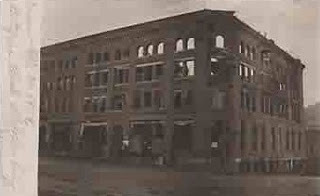 I've had this photo (blurry though it is) on the Pinterest site for COLD MIDNIGHT for a while now -- it's the result of the 1909 fire in St. Johnsbury, Vermont, which retired firefighter Dave Brown told me was the disaster that moved the town to purchase up-to-date firefighting gear; the ladders then in use were simply not long enough and fatalities resulted. Now, thanks to Researcher Extraordinaire Dave Kanell (yes, I'm married to him), here's a news report of the fire. Thanks also to Stu Beitler, who posted the piece online in 2007.
I've had this photo (blurry though it is) on the Pinterest site for COLD MIDNIGHT for a while now -- it's the result of the 1909 fire in St. Johnsbury, Vermont, which retired firefighter Dave Brown told me was the disaster that moved the town to purchase up-to-date firefighting gear; the ladders then in use were simply not long enough and fatalities resulted. Now, thanks to Researcher Extraordinaire Dave Kanell (yes, I'm married to him), here's a news report of the fire. Thanks also to Stu Beitler, who posted the piece online in 2007.***
NINE PERSONS DIE AT FIRE
St. Johnsbury, Vt., Suffers Great Loss of Life.
Four-Story Block Burned so Rapidly That Firemen Were Helpless to Save Imprisoned Victims.
St. Johnsbury, Vt. -- Nine lives were lost in the fire which destroyed the principal business building of this town. Two other persons were fatally burned, and two were taken to a hospital suffering from severe but not dangerous burns. The property loss is estimated at $50,000, partly covered by insurance. Of the nine persons killed, two fell from the upper stories of the building in an attempt to reach safety by means of ropes, while seven were burned to death, their bodies not being recovered until several hours later.
The list of dead follows:
S. D. CUSHMAN and MRS. S. D. CUSHMAN and their child;
L. E. DARLING, forty years old, a laborer;
MISS MAY SLEEPER;
CHARLES TANNER, a painter;
MRS. CHARLES TANNER.
MRS. JEANNETTE DAVIS and LOUIS POPE, thirteen years old, son of MR. And MRS. WILLIAM POPE, were those fatally burned. The others injured are WILLIAM POPE and ROY SMITH, who will recover.
The block, a four-story brick building, was a combination of stores, offices, tenements and assembly halls. It was owned by the Citizens' Savings Bank. The fire is believed to have originated in a restaurant in the basement.
Though the alarm was given on the instant and the firemen came in with all speed, the inside of the four-story building was a furnace before help arrived, an elevator well having furnished a flue through which the flames swept to all of the floors.
When it was seen that the ladders would not reach, ropes, which were evidently in the building for such an emergency, were brought into use. Women apparently feared the attempt at descent and RANLETT attempted to come down, hand over hand, to reach he top of the ladder. He lost his balance and fell to the sidewalk. His skull was fractured and he died instantly. DARLING, the other man, lost his grip and fell in attempting to grasp the swinging rope from a windowsill. He lived only a few minutes.
The Cranbury Press New Jersey 1909-11-05
Published on April 13, 2013 15:09
Critical Thinking: Images and History, and Historical Fiction
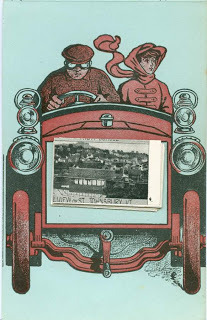
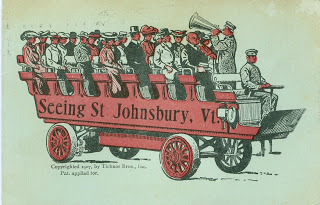 When I visit groups to discuss COLD MIDNIGHT, I often point out the photo of the Chinese man that nearly led me astray when I was working out the plot of the book and its careful pinnings to the history of Chinese arrivals in northern New England in the 1880s. Here's another pair of items, located by my husband Dave, that could be deceptive. They seem to show a touring vehicle, with people on board to look around the town of St. Johnsbury, Vermont. You can see the date 1907 on the card -- the year when the noted postcard company Tichnor Bros. applied for a copyright on the clever pair of images.
When I visit groups to discuss COLD MIDNIGHT, I often point out the photo of the Chinese man that nearly led me astray when I was working out the plot of the book and its careful pinnings to the history of Chinese arrivals in northern New England in the 1880s. Here's another pair of items, located by my husband Dave, that could be deceptive. They seem to show a touring vehicle, with people on board to look around the town of St. Johnsbury, Vermont. You can see the date 1907 on the card -- the year when the noted postcard company Tichnor Bros. applied for a copyright on the clever pair of images.However, although St. Johnsbury did indeed have plenty of tourism in 1907, these images doesn't show the "real thing." (The top one, though, has some real photo images attached to it with an accordion fold.) The cards are among many that were created where town names could be set into the card, and orders placed for "anywhere." Often the cards like this are amusing, and some are romantic, but ... they are stock images, made by the card company without ever visiting the town named on them! That also leads to another entertaining side of the cards as we collect them today: On quite a few that we've seen, the town name has been misspelled!
But it's all in fun, and it was a classic of a hundred years ago.
Just don't count on these for "pictures that show the real thing." They show effect of the tourist trade, instead!
Published on April 13, 2013 12:52
April 10, 2013
Book Club Bounty: The Best Reason to Get Together!
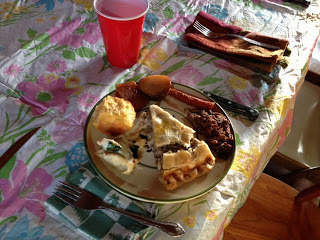
Last Friday evening, eight women from my extended neighborhood (the closest lives a few houses away; at least one had an hour-long drive) gathered for their monthly book discussion, and I was honored by an invitation -- they had (all but one) just read my newest novel, COLD MIDNIGHT, so I brought a display of photos and old postcards that were part of the research for the 1921 setting, and told the tale of the historically read murder of Sam Wah, a Chinese laundry owner who was 75 years old in 1921, in St. Johnsbury, Vermont. (I keep an even larger collection of related images at the book's Pinterest site, here: http://pinterest.com/bethkanell/cold-midnight-climbing-on-roofs-at-night-solving-c.)
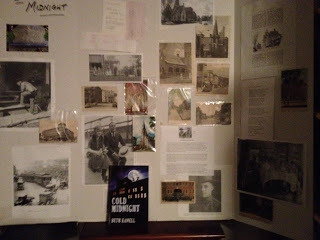 Like another book gathering that I attended a few weeks earlier, this one glowed with the seasoned experience of the women at the table, who brought their complex lives and wisdom to share. It also included a marvelous supper, and I took a moment to photograph my plate, so I could savor the meal in memory! The slice of meat pie at the center of the plate was a special treat for me -- it's the French Canadian "tourtiere," a dish I always enjoy. The crust was flaky, the meat and seasonings savory. And, as you can see, there were many other delights to go with it! But tourtiere was especially significant because of its origin; both COLD MIDNIGHT and my 2008 novel The Darkness Under the Water dip into French Canadian culture and traditions as they've arrived in this northeastern part of Vermont.
Like another book gathering that I attended a few weeks earlier, this one glowed with the seasoned experience of the women at the table, who brought their complex lives and wisdom to share. It also included a marvelous supper, and I took a moment to photograph my plate, so I could savor the meal in memory! The slice of meat pie at the center of the plate was a special treat for me -- it's the French Canadian "tourtiere," a dish I always enjoy. The crust was flaky, the meat and seasonings savory. And, as you can see, there were many other delights to go with it! But tourtiere was especially significant because of its origin; both COLD MIDNIGHT and my 2008 novel The Darkness Under the Water dip into French Canadian culture and traditions as they've arrived in this northeastern part of Vermont.Do you meet with a book club? If your club selects Cold Midnight or The Secret Room, I can provide books at a 20% discount; for The Darkness Under the Water, which I have to order differently, I can give 10% off. Just let me know. (Books, prices, etc. here: www.BethKanell.com.) Talking about a book with others who've enjoyed it -- "priceless."
Published on April 10, 2013 17:22
March 26, 2013
A Salute to A WRINKLE IN TIME -- and a New Voice in This Year's Fiction
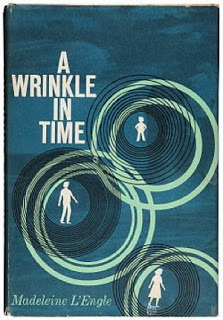 It's hard to believe it, but 50 years have passed since the publication of Madeleine L'Engle's book A WRINKLE IN TIME. "Young adult" fiction before the genre really existed, and providing a powerful journey of spiritual seeking as well as a new definition of courage, this novel is one I've returned to at least every five years or so, to see "how the author did it" -- and why it means to much to me.
It's hard to believe it, but 50 years have passed since the publication of Madeleine L'Engle's book A WRINKLE IN TIME. "Young adult" fiction before the genre really existed, and providing a powerful journey of spiritual seeking as well as a new definition of courage, this novel is one I've returned to at least every five years or so, to see "how the author did it" -- and why it means to much to me.Now I'm honored to present a guest post from Ellen Larson, whose November 2013 book, IN RETROSPECT, connected right away for me to the L'Engle classic. Make sure to connect at the end of this post, too -- there's a role for you in what's ahead for Ellen Larson.
A L’Ove L’Etter to Madeleine L’Engle
The Happy Medium. Tesseract. Sport. Magic words to kids like me who read A Wrinkle in Timewhen it was published in 1962. Such a mysterious, heartrending, and above all inspiring book. My first science fiction read, though I didn’t make that connection at the time. Books were just books to kid me. But I was aware that this book by Madeleine L’Engle was grounded in science, and thus it seemed more real to me than other books I’d read that had a fantasy element, like The Princess and Curdie, or were simply mainstream books like The Lord of the Flies. That bears repeating: More real. Science fiction; more real. What a paradoxical reaction! I was hooked.
In the years that followed, I read Andre Norton, Robert Heinlein, Ray Bradbury, and Isaac Asimov with increasing fervor and preferences. I was never too fond of Heinlein’s big metaphysical hit, Stranger in a Strange Land (didn’t like the sexual politics—though again, I was too young to give my uneasiness a name), but I absolutely loved his lesser known The Door Into Summer, a whimsical love story that hooked me on time travel for life because of its elegant pair of time travel devices. First Heinlein uses have simple cryonics, which allows the hero to go forward in time without aging (hey, it counts!). And second, upon finding himself thirty years in the future, when such things just might be possible, Heinlein introduces a mad genius scientist who has invented a time-travel machine.
What I found compelling about the book—what I find compelling about the best time-travel stories—was that I could literally feel my mind bending as I tried to follow reality as it twisted and seemingly changed. I like that a lot.
As both a writer and a reader I am a fan in intricate plotting, a preference that led me to mystery reading and writing as well, but there is no plotting more complex than a well-told time-travel tale. I crave that moment in the story when reality shifts and appears to rewrite itself, exposing the power of the writer as the plot at last unfolds and the perceived complexity is revealed to be elegant simplicity. And that is only one model of time-travel structure.
In addition to plots like that in The Door Into Summer, in which events remain constant and only perception changes, there are equally mind-boggling tales of parallel universes, altered timelines and epic crossroads in history. This structure generally involves the inevitable happening even though history has indeed been changed by the time-traveling characters. The delight comes from watching the efforts of protagonist or antagonist to cause or prevent the inevitable, in ways we never expect. The iconic Star Trekepisode, The City on the Edge of Forever, written by the great science-fiction author Harlan Ellison, is a prime example of this structure. Though she has earned Kirk’s love and our respect, Edith Keeler must die; Kirk must choose between saving her and upending history, or letting her die. All that needs to be answered is the question of how—and how the moral question will be answered.
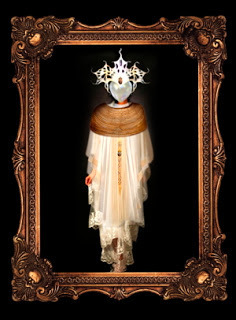 The Prioress from IN RETROSPECT
The Prioress from IN RETROSPECTWhen I came to write my own time-travel story, In Retrospect, I started by choosing the structure that would best suit the idea (the conflict) that was bubbling in my head. The Infinite-Number-of-Parallel-Universes approach works great to explore characters. The Door-Into-Summer approach lends itself to deliciously evil plotting. The Edith-Keeler approach leads to great moral conflict for the characters. I excluded parallel universes first, because while tremendous fun in its way (my first run in with parallel universes came with the iconic Dark Shadows in the 1960s, btw) it doesn’t include the mind-bending aspect I crave.
With apologies for skipping Kurt Vonnegut, this left me with a choice that can best be summed up by the question: In my futuristic world, can history be changed via time travel (Edith-Keeler) or not (Door-Into-Summer)?
I made my choice—but I’m not gong to elaborate here, because in fact the answer to the question is germane to the plot itself. It is also the topic under discussion when my protagonist, Retrospector Merit Rafi, first meets Eric Torre, a wave-aspect physicist with whom her life will be forever entwined:
The boy with the wavy yellow hair gave an argumentative snort. “But you haven’t addressed the question! Why can’t you change history?”“Because you just can’t. Trust me. I’ve been there.” Having settled that issue, Merit raised a paper cup to her lips. Damn, the Rasakans made good wine. She breathed in the sweet summer air and let her gaze roam across the rolling meadows of Bergama. It never ceased to amaze her. Though half the Earth had been destroyed eight hundred years ago by the insanity of their forebears; though the coasts had been redrawn and the climate changed, this land called by the ancients Anatolia, then Asia Minor, then Turkey, had survived, flourished, and—eventually—regained its plenitude. It was a fine day to be sitting on the grass beneath an almond tree drenched in blossoms, a fine day for shooting the metaphysical breeze with new colleagues over a bottle or two between seminars. A damned fine day to be alive.But the boy didn’t seem to have noticed that the debate was over. “That’s pretense, not proof,” he insisted.Merit’s attention snapped back into place. “I beg your pardon?” She peered more closely at his freckled face. It looked mighty stubborn, in a cheerful sort of way. “If somebody asks you why she can’t walk on water, don’t you simply roll your eyes and say, ‘Trust me, you just can’t?’ ”“No.” He shook his finger back and forth—shook it at her, Merit Rafi, graduate of the Oku Science Conservatory, officer of the Civil Protection Force with a full nineteen months’ experience, Select. “I tell her that water molecules are not cohesive enough to support the mass of a human body, nor is the surface tension high enough to resist the static shear—but that if she were a waterbug she could do it.”It’s been a long journey from the day I first cracked open A Wrinkle In Time—the day that set me on the road to writing a time-travel book of my own. I think a thank-you is long overdue. So thank you, Madeleine L’Engle, and Happy Fiftieth Anniversary!
Beth adds: Ellen Larson is currently running a Kickstarter project to fund the making of the book trailer for IN RETROSPECT. Take a look at this exciting project -- the art is amazing, thanks to concept artist Mike Sissons (that's his painting of the Prioress, earlier), the video is close to completion, and there's a role for supporters right now ... and to salute this author and her work, which in my office will go on the same shelf where A Wrinkle in Time now stands.
Published on March 26, 2013 13:50
March 24, 2013
Sugaring at the Cemetery?
I'm headed into writing the last few chapters of ALL THAT GLITTERS, so as I drove to Waitsfield, Vermont, yesterday, I detoured into the downtown of Montpelier to photograph a couple of locations that are featured in the book. Then I paused outside town at Green Mount Cemetery for some quick photos. When I looked at the big maples that edge the cemetery, I paused and stared. Look closely: Can you see the galvanized-metal sugaring buckets fastened to both sides of the maple tree here?? They were on the entire row of trees along the Route 2 edge of the burying ground.
Talk about not wasting any potential for making maple syrup!
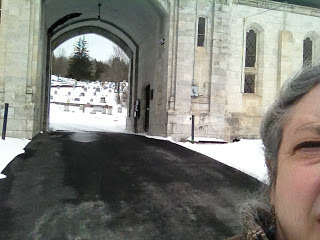
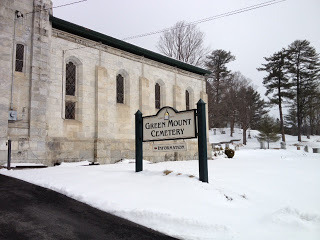
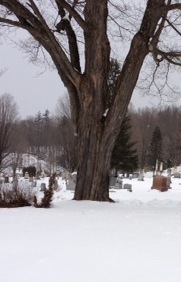
Talk about not wasting any potential for making maple syrup!



Published on March 24, 2013 08:09
March 17, 2013
Rebirth after the Christmas Fire, St. Johnsbury, Vermont
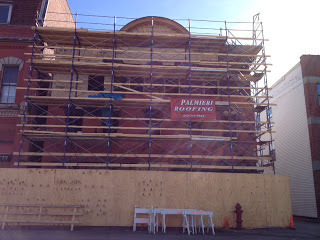 Slowly but surely, St. Johnsbury's "1867 Block" (owned by Bruno Ravel) is rising from the ashes of the structure fire last Christmas; you can see the burned building HERE.
Slowly but surely, St. Johnsbury's "1867 Block" (owned by Bruno Ravel) is rising from the ashes of the structure fire last Christmas; you can see the burned building HERE.And the news story on the fire, from Dec. 24, 2012, is HERE.
I'm watching closely, because (a) I'm so glad to see the structure rise again, (b) I have a lot of respect for Mr. Ravel, who has long been a downtown landlord who cares about his buildings (this one wasn't insured -- but he's having it rebuilt anyway, out of his own pocket and with some help, and (c) it's part of the "back story" for the novel I'll be writing in 2014, THE FIRE CURSE.
Published on March 17, 2013 14:25
Where Plot Ideas Come From: Tracks in the Snow
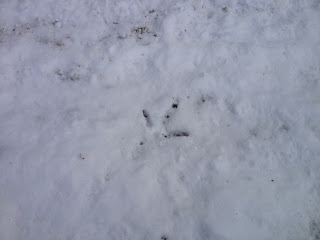 Turkey track, solo ... or so you might think
Turkey track, solo ... or so you might think Two clusters of turkey tracks crossing the stream: Look closely.
Two clusters of turkey tracks crossing the stream: Look closely.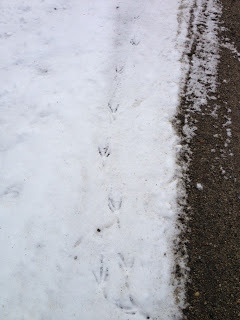 Mourning dove, "pigeon toed."It's cold here this weekend -- bursts of snow keep arriving, and it was nine degrees when I went outside. Although the chickadees call (their two-note mating call) in early morning, the woods go nearly silent later in the day, as we all hold our warmth close, self-protection in what can still be wild winter on the ridge. Tonight's forecast threatens subzero temperatures, not unusual for mid March, although it won't last. The trees are signaling buds and more.
Mourning dove, "pigeon toed."It's cold here this weekend -- bursts of snow keep arriving, and it was nine degrees when I went outside. Although the chickadees call (their two-note mating call) in early morning, the woods go nearly silent later in the day, as we all hold our warmth close, self-protection in what can still be wild winter on the ridge. Tonight's forecast threatens subzero temperatures, not unusual for mid March, although it won't last. The trees are signaling buds and more.Silent though the woods can be, the larger birds are on the move. With the snowcover down to a fragile couple of inches, seeds are everywhere for them with just a quick scratch. How different they are from one breed to another, though. See the solo turkey track in the first photo? It could fool you if you don't follow further -- the second photo, taken not far from the first, reveals that a family of at least half a dozen turkeys passed along here, crossing the stream around the same point.
The third photo means a lot to me as I work slowly to bind all the plot threads together in my "Nancy Drew-style" mystery, ALL THAT GLITTERS. I'm in the last few chapters and it has to go "right" in order to build to the climax I want. There are homing pigeons involved in the plot -- and the tracks in photo 3 are of mourning doves, the wilder sort of pigeon here on the high ridge. I hear their plaintive calls all morning. See how the footprints angle back to each other, always crossing, as the round-bodied bird appears to waddle along? That's where we get the expression "pigeon-toed" -- to walk with one's toes pointed inward, so the right and left feet appear to leave crisscross trails.
The cold air, the photo, the reflection on pigeons, and then, breakfast with strangers at Polly's Pancakes in Sugar Hill, NH, where you often share a table as the staff packs everyone in -- that's what it took to move me to the next component of ALL THAT GLITTERS. Suddenly, I know what's coming next.
PS - You can read the chapters as they are written, at WattPad: http://www.wattpad.com/3668250-all-that-glitters-chapter-1-all-that-glitters-by.
Published on March 17, 2013 08:45
March 7, 2013
Listening to Local (Vermont) History
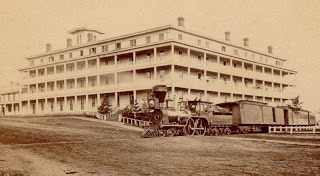 On Sunday morning at 7 a.m. on WIKE-AM radio in Newport, Vermont (1340 AM), Scott Wheeler provides an intriguing conversation each week that delves into this region's culture -- that is, into Northeast Kingdom life, past and present. Today Scott and I savored a conversation about old photo postcard images of Newport and Derby and how they can instigate new work in historical fiction. At least, for Scott and me, they always set the imagination rolling, along with a hunger for more research and more details.
On Sunday morning at 7 a.m. on WIKE-AM radio in Newport, Vermont (1340 AM), Scott Wheeler provides an intriguing conversation each week that delves into this region's culture -- that is, into Northeast Kingdom life, past and present. Today Scott and I savored a conversation about old photo postcard images of Newport and Derby and how they can instigate new work in historical fiction. At least, for Scott and me, they always set the imagination rolling, along with a hunger for more research and more details.One of the images we talked about is this one from the 1880s of the Memphremagog House, a tourist hotel that could shelter about 400 people! Built in 1838, it was a response to the unusual pattern of New England tourism in the 1800s: People would pack their trunks full of necessities and literally leave the city for six months, to enjoy "country air" and escape the fumes of urban life. You can see how close the train tracks ran to the hotel -- passengers could step down from their rail car and stroll up the path to the front door. Scott pointed out that this was one of several hotels at the time; today's regeneration of Newport's downtown has a lot to live up to!
When I'm writing historical fiction, I'm usually working from more than just a place like this hotel, though, and the historical tidbit that I shared with Scott today (it's hard to find one he doesn't know, but I did!) was about Governor George Prouty, a Newport resident. In 1909, the governor's chauffeur took a "joy ride" in the governor's car, crashing into a parade on the west side of the state (part of the 300-year celebration of explorer Samuel de Champlain) and killing a child in the process. The governor made the national news (the New York Times) when he came forward to stand for the $5,000 bail called for, for the chauffeur's manslaughter charge.
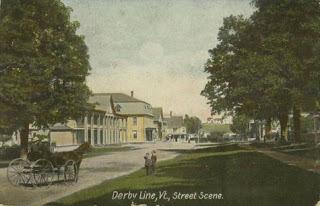
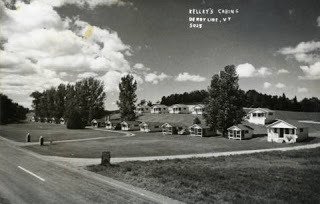
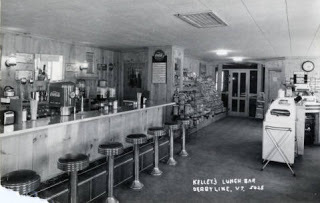 Scott and I also talked about these three Derby Line postcards -- partly for the amount of detail each one captures. In addition, I mentioned that I hope local residents will collect these images before the Internet sells them all to collectors in other places. These are evidence of what life was like, and we need them, in order to hold onto the treasures of our past. They're not just for historical fiction research; they are also for our sense of place, pride, and integrity. Plus, they take up a lot less room than collecting books! (That's a warmly meant family jest, considering how many bookshelves we've filled over the years.)
Scott and I also talked about these three Derby Line postcards -- partly for the amount of detail each one captures. In addition, I mentioned that I hope local residents will collect these images before the Internet sells them all to collectors in other places. These are evidence of what life was like, and we need them, in order to hold onto the treasures of our past. They're not just for historical fiction research; they are also for our sense of place, pride, and integrity. Plus, they take up a lot less room than collecting books! (That's a warmly meant family jest, considering how many bookshelves we've filled over the years.)Other topics: a mention of a Troy resident, Amasa Tracy (1829-1908), the 2004 Phish concert in Coventry that many recall (Scott covered it; he publishes The Northland Journal), and some details of my most recent book, Cold Midnight. Hope you'll tune in for the radio show and catch all of the conversation! Thank you, Scott, for a marvelous half hour.
Published on March 07, 2013 15:36
March 4, 2013
Research for Another Novel: "The Fire Curse"
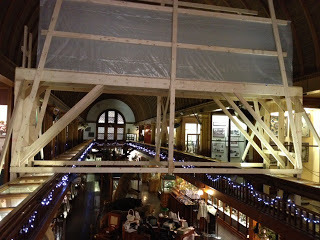 Historical fiction requires years of research for most of us who write it, and the closer we get to the time of writing, the more "picky" we get about details we need -- the length of a skirt, the exact movie being shown, a song being shared.
Historical fiction requires years of research for most of us who write it, and the closer we get to the time of writing, the more "picky" we get about details we need -- the length of a skirt, the exact movie being shown, a song being shared.I'm still in the "wide open" stage of preparing for a book I've tentatively titled The Fire Curse. Recently the Fairbanks Museum & Planetarium in St. Johnsbury, Vermont, closed for two weeks to allow a team to install a "fire suppression system" -- the sensors, electronics, pipes, and pumps that can fight a structure fire before it takes lives. The museum's staff kindly welcomed me to look behind the scenes, and a couple of installation crew members paused for a few minutes to answer some questions that I had. I won't give you details now --- but I wanted to share these photos, because they show something you'll never see again: the moveable scaffold that the installing team created, to slide along the balcony railings upstairs, giving the crew access to the vaulted ceiling of the museum, where sensors and spray nozzles needed to be carefully place. Can you spot the antlers, polar bear, and other museum artifacts here and there?
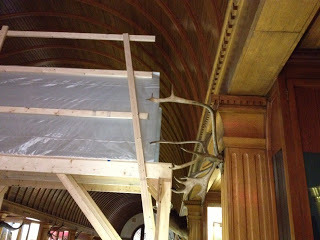
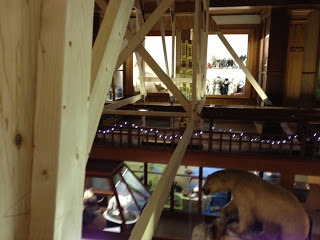
Published on March 04, 2013 08:30
March 3, 2013
The Underground Railroad in Vermont: Call It the "Aboveground Railroad" Instead!
Jane Williamson, director of Rokeby, Vermont's premier authenticated Underground Railroad site, often points out how literal the thinking is of third graders, who arrive at her historic center, eager to see the "trains that run under the ground." She has many other things to show and teach them, but sometimes they are still baffled that they haven't yet found the train.
With adults, both director Williamson and I find widespread attachment to the romance of the Underground Railroad myth in Vermont. As she says, it would be better to call the movement of African-American fugitives here in the 1800s "the Aboveground Railroad." Most Vermonters believed slaveholding was immoral, and that all humans should own their own lives. Dark-skinned fugitives arriving in the state weren't just assisted in their travels -- at places like Rokeby, they also could polish their skills for independent living and move toward owning their own land and businesses, from earned wages that they saved. Moreover, Vermont was so far from the slaveholding states of the American South that the vision of the fugitive cowering in a hidden room while the slavehunter passed by was a fiction; African Americans worked on farms, established homes, and nurtured their families here.
Many otherwise well-informed adults still leap to the conclusion that a "hidden room" in Vermont had a connection to the heroic labors of the Underground Railroad. Usually there are other reasons for such rooms: for hiding alcoholic beverages, or money, or, much later, Chinese migrants barred from entering America from 1882 to the First World War. Sadly, some rooms may have been the final resource of family members who weren't "fit to be out in public." Increasingly, rooms found near chimneys or in much-rearranged homes are remnants of homeowner layout changes -- say, changing from a wide old fireplace to a narrower chimney for a furnace.
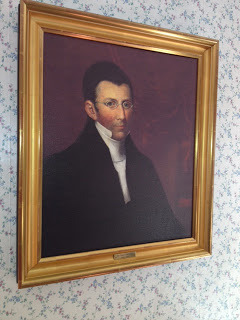
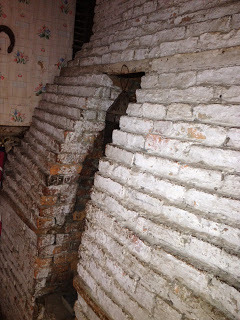 At the Goodwillie House in Barnet, Vermont, a site that plays a role in my book The Secret Room when Shawna and Thea visit to test some of their ideas about the Underground Railroad, there is a double-walled section of the cellar that long had a rumored description as an underground railroad hiding place. I'd rather see it as a place the Rev. David Goodwillie -- who served Barnet as pastor, postmaster, and more -- might have put a few things he didn't want all his relatives to see. Or perhaps his wife stored the best potatoes and carrots there, to still have a few by the time the winter dining reached Easter Sunday!
At the Goodwillie House in Barnet, Vermont, a site that plays a role in my book The Secret Room when Shawna and Thea visit to test some of their ideas about the Underground Railroad, there is a double-walled section of the cellar that long had a rumored description as an underground railroad hiding place. I'd rather see it as a place the Rev. David Goodwillie -- who served Barnet as pastor, postmaster, and more -- might have put a few things he didn't want all his relatives to see. Or perhaps his wife stored the best potatoes and carrots there, to still have a few by the time the winter dining reached Easter Sunday!
Here's a newly acquired portrait of the Rev. Goodwillie, as well as a photo of the brickwork inside the house. There's a lot to explore here, and a lot to discover. Historical research backs up the best of the stories of the Goodwillie House, and one of my favorite bits is knowing that the family here had the first sheet-iron stove in town, and even added pipes to bring water inside the house, quite an innovation at the time.
The Barnet Historical Society opens the Goodwillie House several times each year, and often the town's eighth graders welcome visitors. Inquire for details or make an appointment: http://www.barnetvt.org/historical.php
With adults, both director Williamson and I find widespread attachment to the romance of the Underground Railroad myth in Vermont. As she says, it would be better to call the movement of African-American fugitives here in the 1800s "the Aboveground Railroad." Most Vermonters believed slaveholding was immoral, and that all humans should own their own lives. Dark-skinned fugitives arriving in the state weren't just assisted in their travels -- at places like Rokeby, they also could polish their skills for independent living and move toward owning their own land and businesses, from earned wages that they saved. Moreover, Vermont was so far from the slaveholding states of the American South that the vision of the fugitive cowering in a hidden room while the slavehunter passed by was a fiction; African Americans worked on farms, established homes, and nurtured their families here.
Many otherwise well-informed adults still leap to the conclusion that a "hidden room" in Vermont had a connection to the heroic labors of the Underground Railroad. Usually there are other reasons for such rooms: for hiding alcoholic beverages, or money, or, much later, Chinese migrants barred from entering America from 1882 to the First World War. Sadly, some rooms may have been the final resource of family members who weren't "fit to be out in public." Increasingly, rooms found near chimneys or in much-rearranged homes are remnants of homeowner layout changes -- say, changing from a wide old fireplace to a narrower chimney for a furnace.

 At the Goodwillie House in Barnet, Vermont, a site that plays a role in my book The Secret Room when Shawna and Thea visit to test some of their ideas about the Underground Railroad, there is a double-walled section of the cellar that long had a rumored description as an underground railroad hiding place. I'd rather see it as a place the Rev. David Goodwillie -- who served Barnet as pastor, postmaster, and more -- might have put a few things he didn't want all his relatives to see. Or perhaps his wife stored the best potatoes and carrots there, to still have a few by the time the winter dining reached Easter Sunday!
At the Goodwillie House in Barnet, Vermont, a site that plays a role in my book The Secret Room when Shawna and Thea visit to test some of their ideas about the Underground Railroad, there is a double-walled section of the cellar that long had a rumored description as an underground railroad hiding place. I'd rather see it as a place the Rev. David Goodwillie -- who served Barnet as pastor, postmaster, and more -- might have put a few things he didn't want all his relatives to see. Or perhaps his wife stored the best potatoes and carrots there, to still have a few by the time the winter dining reached Easter Sunday!Here's a newly acquired portrait of the Rev. Goodwillie, as well as a photo of the brickwork inside the house. There's a lot to explore here, and a lot to discover. Historical research backs up the best of the stories of the Goodwillie House, and one of my favorite bits is knowing that the family here had the first sheet-iron stove in town, and even added pipes to bring water inside the house, quite an innovation at the time.
The Barnet Historical Society opens the Goodwillie House several times each year, and often the town's eighth graders welcome visitors. Inquire for details or make an appointment: http://www.barnetvt.org/historical.php
Published on March 03, 2013 14:39



